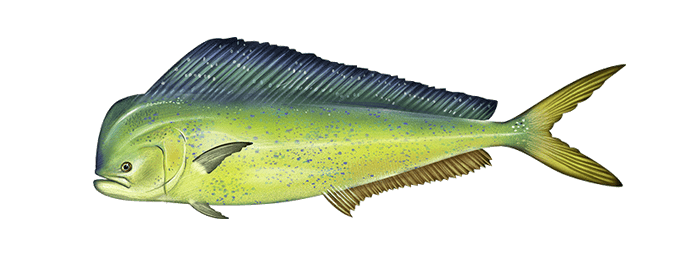Mahi-Mahi (Coryphaena hippurus)
Mahi-Mahi, also known as Dolphinfish, Dorado, Lampuga or Goldmakrele, is one of the most colorful fish in the sea. The name Mahi-Mahi comes from Hawaii and means “Strong Strong”. The name was changed to Mahi-Mahi after much confusion with the public thinking restaurants were serving the other type of Dolphin for dinner. The top of the fish is a dark bluish green which fades into a neon green/yellow on the size and bottom of the fish. The body of the Mahi-Mahi tapers sharply from the head to the tail with small irregular blue, green or yellow patches scattered on the side of the fish. There unique shape and vibrant colors make them one of the most sought-after game fish to catch in Florida. When they get excited a Dolphin can sometimes flash purple, chartreuse and various other colors. The adult male is referred to as a Bull Dolphin or Bull and has a near verticle head which is how they received that name. The adult females have more of a sloped head and are referred to as Cows. Mahi-Mahi is a pelagic saltwater fish that can be found in a variety of sizes from schoolies to Bull Dolphin. The average sized Dolphinfish you will catch off the Florida coast is usually around 30 pounds. They can reach sizes of up to 63 inches and weigh as much as 88 pounds. The largest Dolphin Fish ever caught in Florida was a massive 81 pounds. They are one of the fastest growing fish and can grow up to three feet in length during their first year. They are also very fast swimmers that can live up to 5 years. The most exciting part of catching Dolphin is watching them jump out of the air when they’re hooked. Smaller schoolie dolphins are usually found in schools. Once you land a Mahi-Mahi on the boat they immediately start to lose their color. Mahi-Mahi is one of Florida’s most beautiful saltwater game fish as well as very tasty. They are from the same family as the Pompano.
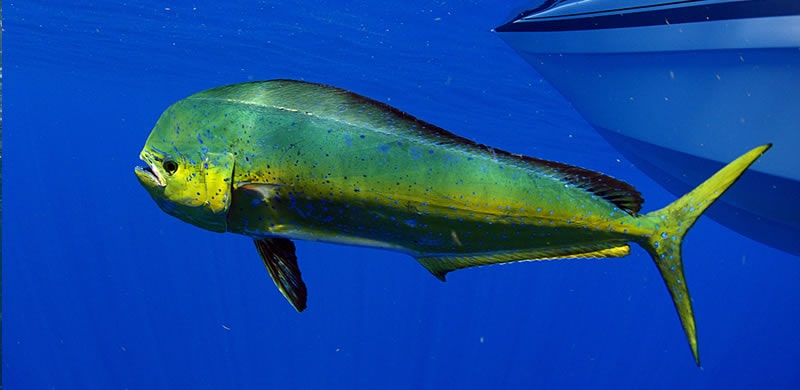
How to catch Mahi-Mahi in Miami
The tackle you use for catching dolphin can vary from light spinning tackle to catch smaller schooling dolphin, to heavy trolling equipment for Big Bull Dolphin. Once you hook a schoolie they key is to leave them in the water as long as possible so that the other schoolies and bulls nearby come around. If the first one you catch is over 20 pounds you should put him on the boat to avoid losing your hooked Mahi. You’ll want to be careful with the dolphin you leave in the water because it is very common that a Shark, Cuda, Wahoo or even a Marlin can come up and snatch your fish. If your fishing for Dolphin you need to have a minimum of two rods so that you can leave one in the water while you pull out the rest of the fish nearby. When you hook a Mahi-Mahi get ready for a battle, these fish pull hard and make short burst flying out of the water to try and shake the hook. Chumming the water is another great tactic to get the Dolphin to come close. The cum attracts baitfish and causes activity in the area your fishing. If you want to catch a big Bull then trolling with large horse ballyhoo rigs with a 100-pound fluorocarbon leader will do the trick. Using a big bait will eliminate the smaller schoolies from going after your bait. If you’re trolling around heavily scattered sargassum mats then adding a small skirt to your ballyhoo will help you to grab fewer weeds. When creating a weedless ballyhoo rig you should also put the hook point in reverse in order to grab fewer weeds. To do this you need to put the hook through the gill slit of the ballyhoo and out through its throat. Once you pull the point of the hook through you need to reverse the point and stick it back into the fish. After that, you can pass a strand of wire through the eyes and then make five to six wraps around the head and extending unto the leader. Once your done you can scale the bottom of the ballyhoo near were the hook is in order to make it softer allowing the hook to come out when the fish strikes. You should also have a naked chin-weighted ballyhoo to use as a pitch bait when the schoolies are near the boat. As always using a bigger bait will help you land more keepers and keep the smaller dolphin away from your bait. Using a squid nation dredge, 96-fish Stripteaser dredge or the best option which is a Tournament Cable system like an EZ/6 Dredge. The dredges imitate a school of baitfish chasing the boat and can attract much more bites. A combination of real baits and stick baits or rubber paddle tails is a great way to add variety to the dredge. Make sure to place the dredge in clean water away from the boat wash to maximize visibility. Trolling, Drifting, Jigging and Casting are all good methods but trolling is the most popular method of targeting Dolphinfish in Florida. When trolling for Mahi Mahi you want to keep a speed from six to seven mph.
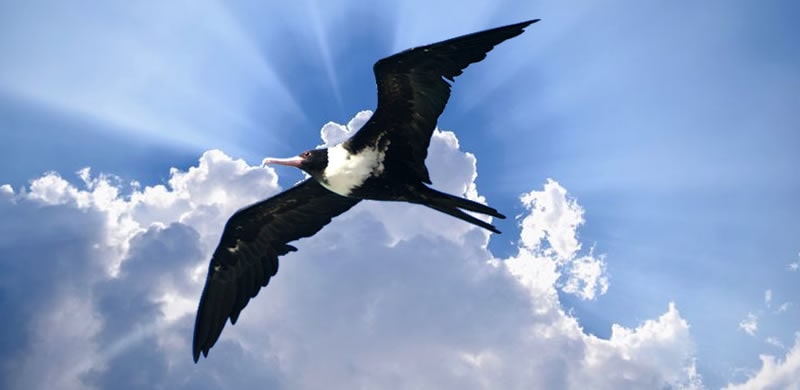
Where to fish for Mahi-Mahi
Florida is the Dolphin fishing capital of the world. If your fishing for Mahi-Mahi in South Florida and the Florida Keys then you’re going to want to go anywhere between 10 and 30 miles offshore in blue water with a depth between 90 feet and 300 feet. They prefer warm waters above 68 degrees and are usually found near floating mats of sargassum, trees, logs, drifting buoys, moored buoys, and any type of material that is floating in the sea. Floating ocean weed lines and debris create a shelter for baitfish similar to a reef and can attract large schools of Mahi-Mahi. Binoculars are a great addition to your Dolphin catching setup as you can look for frigate birds nearby. Frigatebirds circling around a spot and diving into the water’s surface usually indicate there is bait in the area. The birds can spot fish up to 100 feet deep. The bait balls move to the surface to avoid getting eaten by schools of game fish that are chasing after them. If you see frigate birds or terns hovering over debris you can almost always find a couple Dolphin close by. Going on a dolphin fishing charter in Miami is a great way to almost always guarantee you catch a dolphinfish. Florida fishing charters have experience finding the Dolphinfish as well as the right bait and fishing gear to land Big Bulls. After heavy rainfall or storms is a great time to go after Dolphin because there is plenty of debris floating in the ocean that provides cover to small baitfish and lures in the Dolphinfish. Once you find a school the key is to keep them around by throwing pieces of ballyhoo pilchards and sardines. Using Chum is a great way to keep them swimming around the boat. To land the larger Bull dolphin you want to be in water between 250 feet and 500 feet in the Gulf Stream around 20 to 40 miles offshore. The northern edge of the Gulf Stream carries floating debris and sargassum mats that make it a great habitat for all types of pelagic species such as mahi-mahi. The Gulfstream usually runs anywhere from three to five miles off the beaches of South Florida and the Florida Keys.
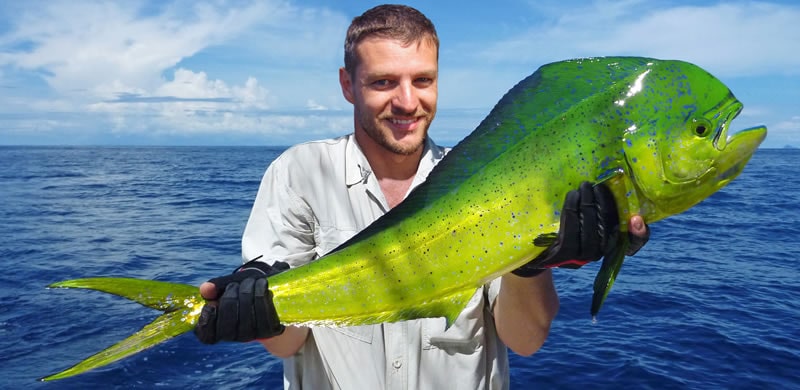
Best time of the year to fish for Mahi-Mahi in Miami
The best time of the year to fish for Dolphin is during spring and summer time. From April to June you will find the largest concentrations of dolphin in Florida. They can be caught year round but during these months you are more likely to land the bigger bull dolphins. During the daytime is the best time of the day to fish for Dolphin because they are closer to the surface. During the night time, these fish tend to be deeper in the water column at depths of 70 feet or more. Scanning the local fishing reports will help you to find when and where the dolphin are biting. During a full moon, the Dolphinfish rarely eat so it is one of the worse times to target these fish. No matter how young or old you are catching a Dolphin is a fun adventure.
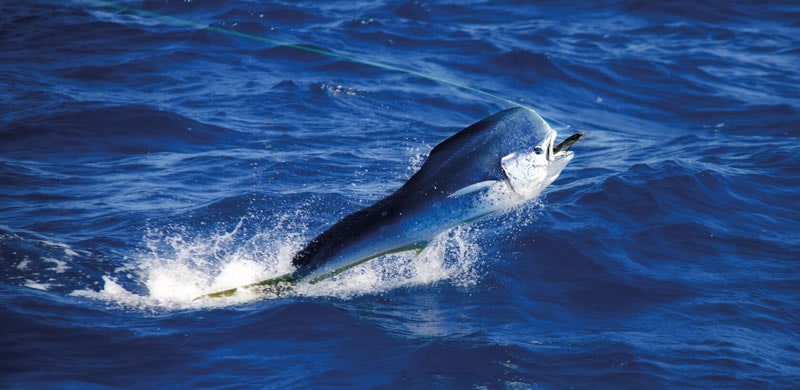
The best bait to catch Mahi-Mahi
Adult Dolphin will eat anything from blue runners, mullet, flying fish, squid and even crabs. The most common bait is a dead ballyhoo or cigar minnow rigged up with one or two hooks and trolled along mats in the ocean. Live Ballyhoo and Flying fish are the best live baits to catch Mahi-Mahi in Florida. You also want to have one or two blocks of chum in the water to keep them around as well as some cut up bait to throw chunks in the water and keep them near the boat. They can also be caught using cut bait(squid, sardines, ballyhoo), artificial lures, bottom jigs, flies, popping bugs or flashy spoons. Once you have one in the water and the school is circling the area they will usually go after any type of bait you throw in. The larger dolphin is usually found by themselves or with one or two other adult dolphins. The bigger bull dolphin is much smarter and may only go after live bait. Make sure you have a couple live baits on the boat just in case that trophy Dolphin comes by to check out all the commotion. You want to use a 6 or 7/o Mustard hook with a fluorocarbon leader of 50 pounds or more attached to 60 or 70-pound braid using a double uni knot. These fish can pull pretty hard and can sometimes break free of the line when they jump out of the water. Trolling lures are also very popular because they last longer than natural bait and don’t wash out. Whеn using lurеѕ they рrеfеr lаrgеr spinners, and flоаting lurеѕ, thаt have lоng ѕkirtѕ оn thеm which imitate осtорuѕ or squid.
Is Mahi Mahi good eating?
Mahi-Mahi is not only good eating it is one of the best-eating fish in the sea. You can prepare them in several ways but the most common methods are in fillets or steaks. They have a lean flesh and a moderately firm texture with large moist flakes and a mild, sweet flavor. Before you cook Mahi-Mahi you should remove the skin. It can also be crusted, sautéed, broiled, baked, blackened, crusted and can even be prepared as ceviche. If your shopping for Mahi Mahi at the grocery store make sure it has a translucent pinkish flesh and a bright red bloodline. If the bloodline is brownish then the fish is old and you should not buy it. They are very healthy fish to eat and contain lots of protein and all the essential amino acids you need to keep on fishing. These fish can sometimes contain mercury so you should limit consumption to a four-ounce portion once a week according to the Food and Drug Administration.
Florida Mahi-Mahi fishing regulations
In order to keep any Mahi-Mahi, you catch they must be at least 20″ from the head to the fork. You can keep as many as 10 per angler but no more than 60 per boat whichever is less. There is no closed season so you can fish for Mahi-Mahi year-round in Florida. They can be caught using hook and line or by spearfishing. A current Florida saltwater fishing license is required to fish for all types of saltwater species in Florida including Dolphin. Before going fishing make sure you can obtain a license from the Florida Fish and Wildlife Conservation Commission by going online, calling or going to a bait and tackle shop. If you’re going on a fishing Charter in Florida then chances are it’s included with the booking fee. Florida residents who are fishing from shore, bridges or piers can get a recreational saltwater shoreline fishing license, which is free of charge.


